|
|
|
6. und 7. Leibniz-Festtage 2009/2010 : Predigten und Vorträge in der evangelisch-lutherischen Neustädter Hof- und Stadtkirche St. Johannis, Hannover ; Leibniz im Garten der Vernunft ; Glauben und Wissen.
Hannover, Hora-Verlag, 2011. 137 Seiten, H 21 x 15 cm, OKart. - Sehr guter Zustand. broschiert/ Taschenbuch/ paperback
Bookseller reference : PHI965

|
|
|
Akten d. II. Internationalen Leibniz-Kongresses, Hannover, 17.-22. Juli 1972. Bd. 2: Wissenschaftstheorie u. Wissenschaftsgeschichte.
Wiesbaden, Steiner, 1974. 3 Bl., 325 S. Lwd. (Studia Leibnitiana. Suppl. 13).
Bookseller reference : 606310
|
|
|
Akten des Internationalen Leibniz-Kongresses Hannover, 14.-19. November 1966. Bde. 1, 3-5.
Wiesbaden, Steiner 1968-71. Gr.8°. Oln.
Bookseller reference : 304396-1
|
|
|
Bayle's & Leibniz' dröftelse af theodice-problemet - zwei Bände.
Köbenhavn Munksgaards Forlag, 1965. 745 S. 4° Quart Brosch. 2 Bände
Bookseller reference : 16412

|
|
|
Beiträge zur Leibniz-Forschung. Hrsg. v. G. Schischkoff.
Reutlingen, Gryphius, (1947). 240 S. OBr. Etwas berieben. St. a. Tit. (Monogr. z. philos. Forsch. 1).
Bookseller reference : 605891
|
|
|
Geist d. Herrn v. Leibnitz oder auserlesene Gedanken üb. d. Religion, Moral, Sprachen u. Geschichte aus allen seinen Werken zusammengetragen. Dt. v. (L.L.W. Brunn). Bd. 1-2 (von 4) in 1.
Wittenberg, Zimmermann, 1775. 178 S., 4 Bl., 250 S. Ldr. d. Zt. Einbd. leicht berieben. Rücken gering beschäd.
Bookseller reference : 606571
|
|
|
Leben und Werk von G.W. Leibniz. Eine Chronik. Bearbeitet von Kurt Müller und Gisela Krönert.
Frankfurt am Main, Klostermann 1969. 1969. Gr. 8°, 331 S. mit einigen s/w Tafeln. Orig.-Karton.
Bookseller reference : 94526

|
|
|
Leibniz (The) Renaissance. International Workshop (Firenze, 2-5 giugno 1986).
cm. 17 x 24, 308 pp. Biblioteca di storia della scienza Inglese 610 gr. 308 p.
|
|
|
Leibniz zu seinem 300. Geburtstag. 1646-1946. Mit Beiträgen von E. Benz, W. Conze, I. Döhl, K. Dürr, N. Hartmann (Leibniz als Metaphysiker), E. Hochstetter, J. E. Hofmann, R. F. Merkel, K. Reidemeister, J. Steudel, R. Zocher u.a. Lieferung 1-6 in 1 Band.
Berlin, Walter de Gruyter, 1946-1951. Gr.-8vo. Einzeln paginiert. Moderne Lwd. m. RSchild.
Bookseller reference : 8526

|
|
|
Leibniz-Faksimiles. Bekanntes und Unbekanntes aus seinem Nachlaß. Übersetzt, transkribiert und erläutert mit Unterstützung der Niedersächsischen Landesbibliothek Hannover. Herausgegeben von der Stiftung Volkwagenwerk. Mit einem Beitrag von Joachim Otto Fleckenstein über Leibniz und die Wissenschaftlichen Akademien. 2 Bände.
Hildesheim/New York, Olm, 1971. 4°, VIII, 66 Seiten mit montiertem farbigen Titelportrait; 14 Faksimiles auf 24 losen, meist gefalteten Blättern. Orig.Karton / Mappe in illustrierter Orig.Pappkassette.
Bookseller reference : 22467
|
|
|
Leibniz. Tradition und Aktualität. V. Internationaler Leibniz-Kongreß... Vorträge. 2 Bde.
Hannover, Gottfried-Wilhelm-Leibniz-Gesellschaft 1988. 1080; 396 S. Okt.
Bookseller reference : 192117-1 ISBN : 398009782
|
|
|
Leibniz. Werk und Wirkung. IV. Internationaler Leibniz-Kongreß... Vorträge. 2 Bde.
Hannover, Gottfried-Wilhelm-Leibniz-Gesellschaft 1983. 967; 246 S. Okt.
Bookseller reference : 192120-1
|
|
|
Spinozas Ethik und ihre frühe Wirkung. Herausgegeben von Konrad Cramer, Wilhelm G. Jacobs und .Wilhelm Schmidt-Biggemann. Vorträge gehalten anlässl. des 8. Wolfenbütteler Symposions vom 6. - 8. Dezember 1979 in der Herzog-August-Bibliothek.
Wolfenbüttel: Herzog August Bibliothek 1981. 130 S. 23 x 15 cm. Original-Broschur. (= Wolfenbütteler Forschungen. Herausgegeben von der Herzog August Bibliothek. Band 16.)
Bookseller reference : 63929

|
|
|
"(LEIBNITZ, G.W.) G.G.L. [= GOTTFREDUS GUGLIELMUS LEIBNITZ el. LEIBNIZ].
Specimen Novum Analyseos pro Scientia Infiniti, circa Summas & Quadraturas. [In: Acta eruditorum anno MDCCII publicata]. - [THE INTEGRATION OF RATIONAL FUNCTIONS]
Lipsiae [Leipzig], Gross, Frisch and Groschuf, 1702. 4to. Entire volume present. Bound in a nice contemporary full vellum with handwritten year and an old library-label to spine. A bit of soiling. Internally evenly brownspotted throughout, occasionally with heavier brownspotting (not the Leibnitz-article). Discreet stamp ti title-page and to first leaf of text. Pp. 210-219 + one folded plate (""Regulae universales pro fractionibus numeratoris indeterminati...""). [Entire volume: (2), 566 pp. + 9 folded engraved plates.
Bookseller reference : 41371
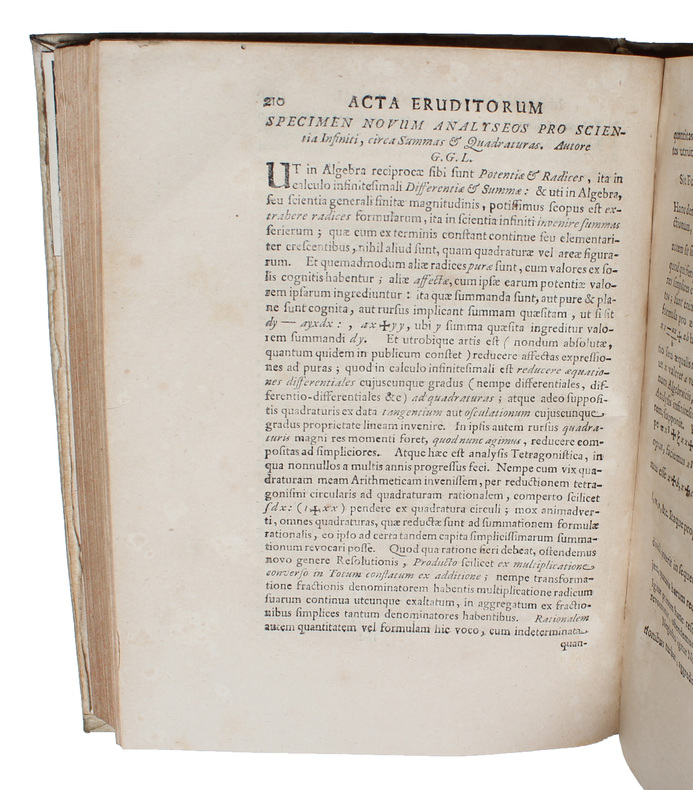
|
|
|
"(TSCHIRNHAUS, EHRENFRIED W. von.). - URGING LEIBNIZ TO PUBLISH ON THE CALCULUS.
Methodus datae figurae, rectis lineis & curva Geometrica terminate, aut Quadraturam, aut impossibilitatem ejusdem Quadraturae determinandi. (+) Nova Methodus determinandi Maxima & Minima.
Leipzig, Grosse & Gleditsch, 1683. 4to. Without wrappers. In: ""Acta Eruditorum Anno MDCLXXXIII"", No.III + X (March and October issues). Pp. 81-128 + pp. 417-464 a. 2 engraved plates. (Entire issues offered). Tschirnhaus's papers: pp. 122-124 + pp. 433-437. Some browning as usual.
Bookseller reference : 45599
|
|
|
"[LEIBNIZ, GOTTFRIED WILHELM].
Collectanea Etymologica illustrationi linguarum veteris Celticae (+) Elogium Godofredi Guiliemi Leibnitii (+) Problema Posthum ab incomparabili Viro Perillustri Dn. Godefrido Guilielmo Lib (+) Notitia de Historia Brunsuicensi. - [LEIBNITZ'S OBITUARY BY WOLFF IN ACTA ERUDITORUM]
Leipzig, Grosse & Gleditsch, 1717. 4to. In: ""Acta Eruditorum Anno MDCCXVII"". The entire volume offered in contemporary full vellum. Hand written title on spine. A yellow label pasted on to top of spine. A small stamp to title-page and free front end-paper. Library label to pasted down front free end-paper. As usual with various browning to leaves and plates. Pp. 317-322" Pp. 322-336 Pp. 353-360 Pp. 360-362. [Entire volume: (4), 553, (39) pp. + seven engraved plates.].
Bookseller reference : 44194
|
|
|
"[LEIBNIZ, GOTTFRIED WILHELM].
Observatio, quod rationes sive proportiones non habeant locum circa quantitates nihilo minores, et de vero sensu methodi infinitesimalis. - [LEIBNIZ ON INFINITESIMALS]
Leipzig, Grosse & Gleditsch, 1712. 4to. In: ""Acta Eruditorum Anno MDCCXII"". The entire volume offered in contemporary full vellum. Hand written title on spine. A yellow label pasted on to top of spine. A small stamp to title-page and free front end-paper. Library label to pasted down front free end-paper. As usual with various browning to leaves and plates. Pp. 167-69. [Entire volume: (2), 555, (35) pp. + five engraved plates.].
Bookseller reference : 44073
|
|
|
"LEIBNIZ (LEIBNITZ), G.F. - JOHANN BERNOULLI - JAKOB BERNOUILLI. - CHRISTIAAN HUYGENS ET AL. - INTRODUCING THE LEMNISCATE CURVE.
1. Nova Calculi Differentialis. Applicatio & usus, ad multiplicem linearum constructionem, ex data tangentium conditione. 2. Constructio Propria Problematiis de Curva Isochrona Paracentrica....& de constructione linearum transcendentium, una maxima ge...
Leipzig, Grosse & Gleditsch, 1694. 4to. Contemp. full vellum. Faint handwritten title on spine. a small stamp on titlepage. In: ""Acta Eruditorum Anno MDCXCIV"". (2),518 pp.. and 11 folded engraved plates. As usual with various browning to leaves and plates. The entire volume offered. Leibniz's papers: pp. 311-316, pp. 364-375. - Johann Bernoulli's papers: pp. 200-206, pp. 394-99, pp. 435-437, pp. 437-441. - Huygen's papers: pp. 338, pp. 339-41. - Jakob Bernoulli's papers: pp. 262-276, pp. 276-280, pp. 336-338, pp. 391-400. Some mispaginations.
Bookseller reference : 41704
|
|
|
"LEIBNIZ (LEIBNITZ), G.F. - CHRISTIAAN HUYGENS - JOHANN BERNOULLI - JACOB BERNOULLI ET AL. - THE DISCOVERY OF THE ""CATENARY CURVE"" , THE ""LOGARITHMIC CURVE"" AND THE ""POLAR COORDINATES"".
1. De Linea in quam Flexile se pondere proprio curvat, ejeuque usu insignia adinveniendi quotcunque medias proportionales & Logarithmos. - 2. De Solutionibus Problematis Catenarii vel Funicularis in Actis A. 1691, aliisque a Dn. I.B. propositis. (1-2:...
Leipzig, Grosse & Gleditsch, 1691. 4to. Contemp. full vellum. Faint handwritten title on spine. a small stamp on titlepage. In: ""Acta Eruditorum Anno MDCLXXXXI"". (8),590,(6) pp. and 13 (of 15) folded engraved plates. The 2 first plates lacks, but they do not belong to the papers listed.Leibniz' papers: pp.277-281 a. 1 plate, pp. 435-439. Johann Bernoulli: pp. 274-276 a. 1 plate. Huygens: pp. 281-282. - Jacob Bernoulli: pp. 282-290 a. 1 plate.
Bookseller reference : 41859
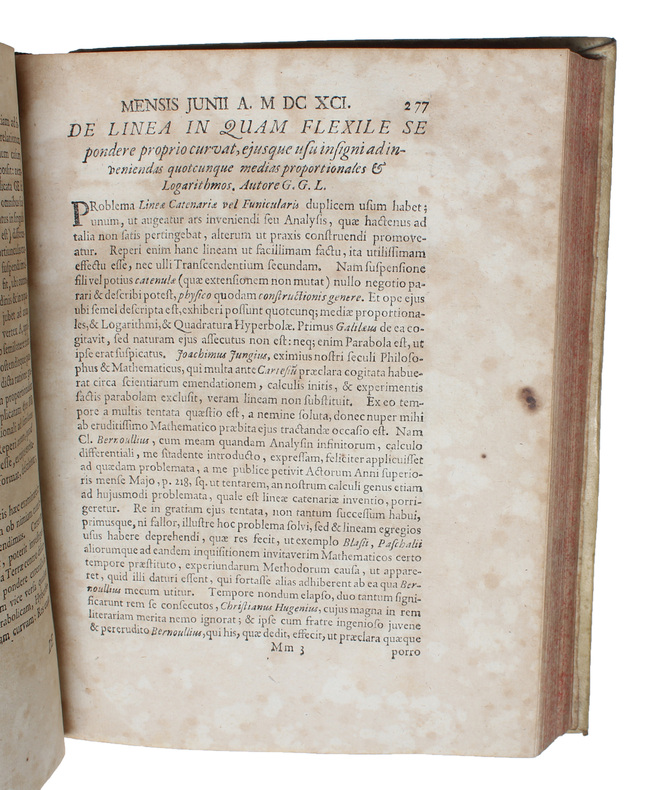
|
|
|
"LEIBNIZ (LEIBNITZ), G.F. - THE APPEARANCE OF THE THEORY OF NORDIC ISRAELISM OR NORSE ISRAELISM.
Accessiones Historicae quibus potissimum continentur Scriptores Rerum Garmanicarum, & aliorum, hactenus inediti sequentes. Tom. I-II. Tom. I: 1. Chronographus Saxo. 2. Joh. Vito Durani Chronicon. 3. Gesta Trevirorum. 4. Vetus Chronicon Holsatiæ. (Tom....
Hannover, Nicolai Förster, 1700 - Leipzig, Nicolai Förster, 1698. 4to. Contemp. full calf. Raised bands, richly gilt spine. (16),315,40,124,119 pp. Tome 2: (12),292,592 pp. First titlepage and Praefatio (16) leaves a bit browned, otherwise clean with only a few scattered brownspots. Some neath marginal notes in 2 contemporary hands.
Bookseller reference : 46424
|
|
|
"LEIBNITZ (LEIBNIZ), GOTTFRIED WILHELM.
Lettres de M. de Leibnitz á M. Herman. Part I-II. (I.No. I-III - II. No. 1-26).
(Berlin, Haude et Spener, 1759). 4to. No wrappers as issued in ""Memoires de l'Academie Royale des Sciences et Belles Lettres"". tome XIII, 1757. Titlepage (Classe de Philosophie Spéculative) and pp. (451-)522.
Bookseller reference : 42999
|
|
|
"LEIBNITZ, Mr. de (GOTTFRIED WILHELM LEIBNIZ).
Oeuvres philosophiques latines & francoises de feu. Tirées de ses manuscrits qui se conservent dans la bibliotheque royale a Hanovre et publiées par Mr. Rud. Eric Raspe. Avec une Préface de Mr. Kaestner. [Nouveau essais sur l'entendement humain, -New ... - [FIRST PRINTING OF ""NEW ESSAYS ON HUMAN UNDERSTANDING""]
Amsterdam et Leipzig, Chez Jean Schreuder, 1765. 4to. Uncut in the original marbled boards. Professionally rebacked preserving almost all of the original back. The fragile orginal binding is here preserved in its entirety, and it has quite a bit of overall wear. Apart from a small hole to two leaves in the index, affecting ab. one work on each of the four pages, it is internally nice and clean. Title-page printed in red and black. Beautiful eng. title-vignette and a few other woodcut vignettes and initials. (4), XVI, (2), 540, (18) pp.
Bookseller reference : 38096
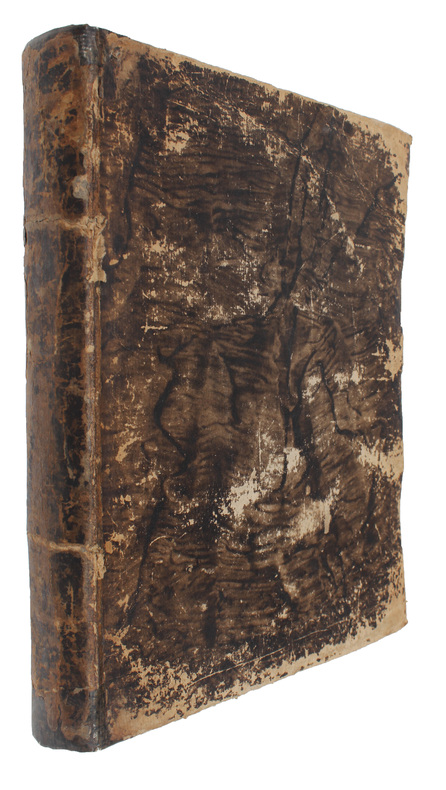
|
|
|
"LEIBNIZ, G.G. - LEIBNITZ [+ CHRISTIAN WOLFF].
Principia Philosophiae [i.e. ""The Monadology""/""Monadologie""/""Theory of Monads""] + (Chr. Wolff:) Das Herrn Gottfrid Wilhelm von Leibnitz Lehrsätze über die Monadologie &c... [In: Actorum Eruditorum, Supplementa. Tomus VII + Acta Eruditorum anno 1721]. - [THE MONADOLOGY - A NEW PHILOSOPHY]
Leipzig, 1721. 4to. Both entire volumes (Acta Eruditorum 1721 + Supplementa VII, 1721) present, in uniform contemporary full vellum bindings with handwriting to spines. A small later label to top of spines. Old handwritten ex libris-inscription to top of both title-pages as well as a small stamp. The supplement-volume with an additional stamp to title-page, and both volumes with library label (Archiv des k.k. militär.-geograf Institutes) to pasted down front free end-paper. As usual some brownspotting. A nice set. pp. 500-514 (Supplement-vol.) + pp. 94-95. [Entire volumes: (2), 537, (39) pp. + three plates (Suppl.-vol.) + (4), 547, (42) pp. + five plates].
Bookseller reference : 49396
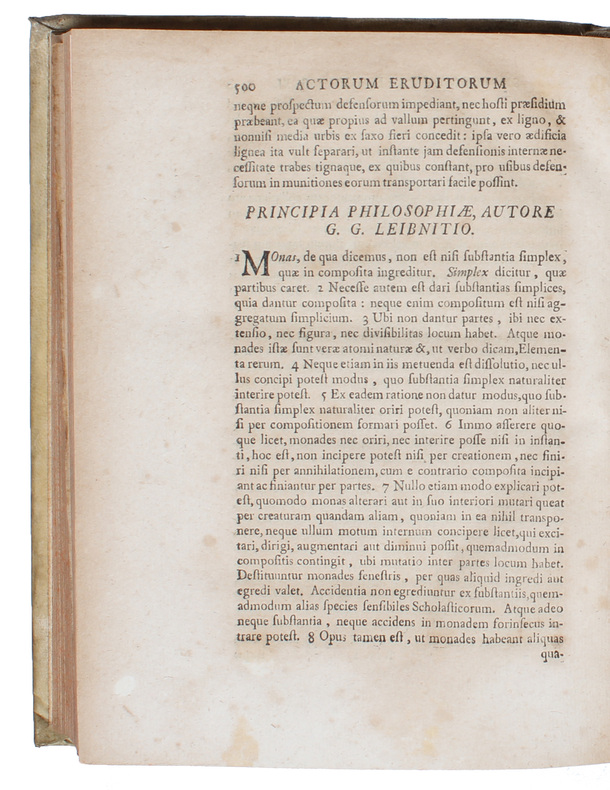
|
|
|
"LEIBNITII, GODOFREDI GUILIELMI. (GOTTFRIED WILHELM LEIBNIZ) & BERNOULLII (IACOBI). (JACOB BERNOULLI) & BERNOULLII (IOHANNIS). (JOHANN BERNOULLI).
Specimen Dynamicum (+) Notatiuncula Constructiones Lineae in qua Sacoma aequilibrium cum pondere moto faciens incedere debet. Et quaedam de Quadraturis (+) Resposio ad nonnullas Difficultates a Bern. Nieuwentüt circa Methodum differentialem motas (+) ... - [FIRST PUBLICATION OF THE ""BERNOULLI EQUATION"".]
Leipzig, Grosse & Gleditsch, 1695. 4to. Contemp. full vellum. Faint handwritten title on spine. A small stamp on titlepage and pasted library label to pasted down front free end-paper. In: ""Acta Eruditorum Anno MDCXCV"". (2), 560, (52) pp. + 10 plates. As usual with various browning to leaves and plates. The entire volume offered. Leibniz's papers: pp. 145-57" 184-185 310-316 369-372 493-495. Jacob Bernoulli's paper: pp. 537-553 + one folding table 65-66. Johann Bernoulli's: pp. 59-65" 374-376.
Bookseller reference : 42860
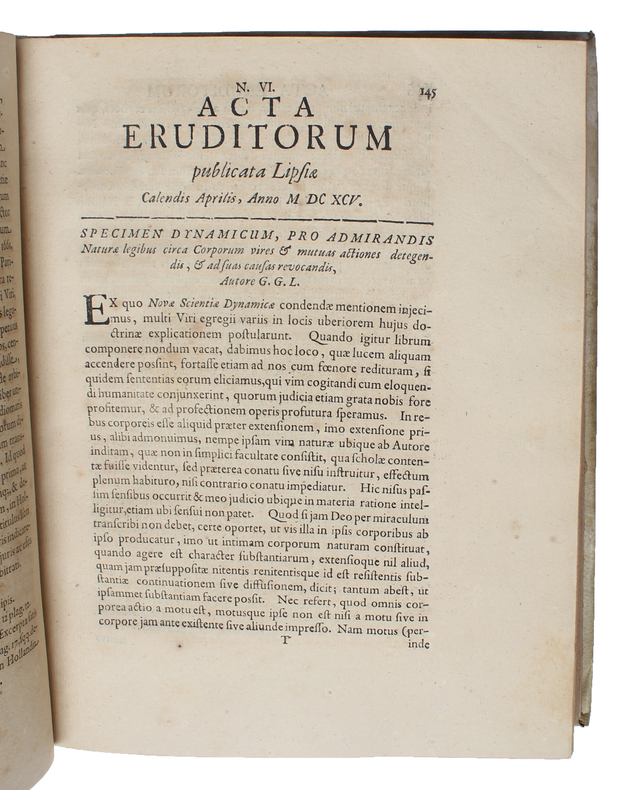
|
|
|
"LEIBNIZ, GOTTFRIED & JOHANN BERNOULLI & JAKOB BERNOULLI & EHRENFRIED WALTHER VON TSCHIRNHAUS.
Supplementum defectus geometria Cartesianae circa inventionem locorum. [Joh. Bernoulli] + [Two other papers]. Notatiuncula ad acta decemb. 1695. [LEIBNIZ]. - [THE BRACHISTOCHRONE PROBLEM]
Leipzig, Grosse & Gleditsch, 1696. 4to. Entire volume present. Nice contemporary full vellum. Small yellow paper label pasted to top of spine and library-label to front free end-papers. Internally some browning and brownspotting. Overall a nice and tight copy. [Bernoulli paper:] pp. 264-69. [Leibniz-paper:] pp. 45-47. [Entire volume: (2), 603, (1) pp. + plates].
Bookseller reference : 42863
|
|
|
"LEIBNIZ (LEIBNITZ), GOTTFRIED WILHELM.
Tentamina Theodicaeae De Bonitate Dei Libertate Hominis Et Origine Mali / Latinè versa & Notationibus illustrata à M. D. L. (Barth. Des Bosses). Ab ipso Auctore emendata & auctiora. Tomus Primus (3 Parts, all). (Theodicy: Essays on the Goodness of God...
Franckfurt, Bencard, 1719. 8vo. Contemp. full vellum. A few small brownspots to covers. Large engraved titlevignette. (48),(40),408,(12) pp. 1 folded table (between p.48/49). Clean and fine.
Bookseller reference : 49802
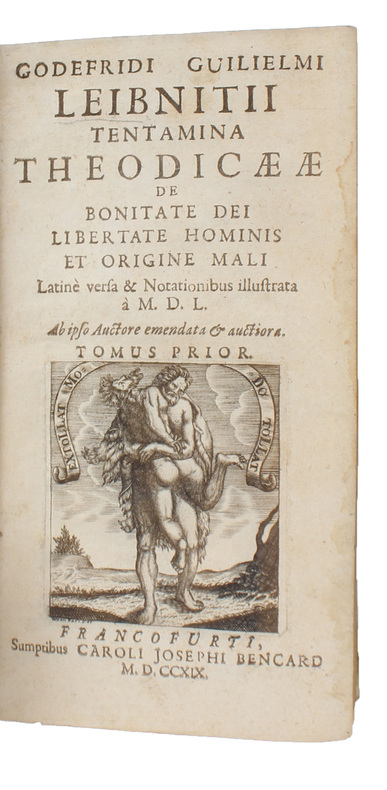
|
|
|
(DES MAIZEAUX, PIERRE) (DESMAIZEAU). (EDT.). - NEWTON, LEIBNIZ, CLARKE.
Recueil de diverses Pieces, sur la Philosophie, La Religion naturelle, L'Histoire, les Mathematiques, &c par Mrs. Leibniz, Clarke, Newton, & autres Aucteurs célèbres. Seconde Edition, Revue, corrigée, & augmentée. 2 Vols.
Amsterdam, Francois Changuion, 1740. Small 8vo. Bound in 2 fine contemp. full calf. Profusely gilt spines, title-and tomelabels in leather with gilt lettering. Gilt border on covers. Titlepages in red/black with engraved vignettes. CII,(2),429(6),550 pp. and 2 engraved plates, each with 3 portraits (Leibniz, Newton, Clarke). Printed on good paper. Internally fine and clean.
Bookseller reference : 46487
|
|
|
(LEIBNITZ, G.W.) G.G.L. [= GOTTFREDUS GUGLIELMUS LEIBNITZ el. LEIBNIZ].
Leibnitzens System der Theologie. Nach dem Manuskripte von Hannover (den lateinischen Text zur seite) ins deutsche übersetzt von Andreas Räss un Nikolaus Weis, mit einer Vorrede von Lorenz Doller. Zweite Auflage.
Mainz, Simon Müller'schen Buchh., 1820. Contemp. full mottled calf. Titlelabel with gilt lettering. VI,CXXVI,346,(2) pp. A faint dampstain to lower right corners of thelast ca. 40 lvs. Clean and printed on good paper. German-Latin paralelltext.
Bookseller reference : 44416
|
|
|
(LEIBNIZ) - BECCO Anne
MONADO 74. DU SIMPLE SELON LEIBNIZ. Discours de métaphysique et monadologie. Étude comparative critique des propriétés de la substance appuyée sur l'opération informatique "Monado 74".
1975 Paris, librairie J. Vrin / éditions du CNRS, collection Philosophie et Informatique, 1975. Préface par Yvon Belaval. In-8 broché de IX - 198 pp. Très bon état, proche du neuf.
Bookseller reference : 18239
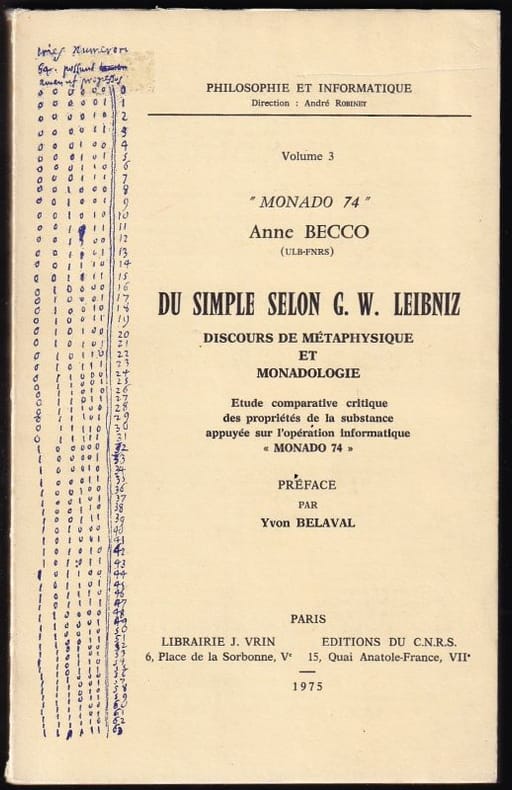
|
|
|
[Commentaire]
COMMENTAIRE - N° 114 (Eté 2006)
Revue trimestrielle fondée par Raymond Aron : 288 pages, format 185 x 255 mm, brochée, bon état
Bookseller reference : LFA-126719576
|
|
|
[LEIBNIZ] MARTIN (Roger)
Deux mémoires sur le calcul différentiel et l'infini
Toulouse, 1782 et 1788, , 2 ouvrages en 1 volume in-4 de 22 pages et 1 planche, puis de 40 pages, demi-veau moderne, dos lisse portant une pièce de titre, Deux mémoires en édition originale tirés des "Histoire et mémoires de l'Académie royale des sciences, inscriptions et belles lettres de Toulouse" (pages 43-64 du premier volume paru en 1782, et pages 29-72 du troisième volume publié en 1788). Roger Martin, appelé aussi Abbé Martin jusqu'à la Révolution, naquit en 1742 à Estadens dans la Haute-Garonne ; brillant élève de sciences, il fut nommé professeur de philosophie à 20 ans au Collège Royal de Toulouse. Passionné de physique et de mathématique, il parvint à faire instaurer dans ce même Collège un cabinet de physique expérimentale ; les leçons qu'il y professait eurent un grand succès. Dans les deux présents mémoires, lus à sept ans d'intervalle devant l'Académie de Toulouse, l'auteur pose le problèmes de l'infini mathématique à l'aune de la méthode du calcul différentiel initié par Newton et développé par Leibniz, tout en appréhendant ses méthodes nouvelles et modernes par le biais de "la méthode des Anciens, connue sous le nom de méthode d'exhaustion ou des limites". Traces de mouillures anciennes sur le premier mémoire. Couverture rigide
Bookseller reference : 60306
|
|
|
[LEIBNIZ] - NOURRISSON.-
La philosophie de Leibniz.
Paris, Hachette, 1860, in 8° relié demi-basane, dos orné de filets dorés, VIII-502 pages.
Bookseller reference : 73016
|
|
|
[LEIBNIZ] - PIAT (Clodius).-
Leibniz.
P., Alcan, 1915, in 8° broché, VII-375 pages.
Bookseller reference : 44785
|
|
|
[PHILOSOPHIE] - LEIBNIZ -
Oeuvres philosophiques.
Paris, Librairie Philosophique de Lagrange, 1866; in-8, 695-706 pp., cartonnage de l'éditeur. Les 2 volumes. Avec une introduction et des notes par M. Paul Janet en 2 volumes - Gravure en noir et blanc en frontispice du tome I (portrait). As dos.coins un peu usagés Tampons de bibliothèque en pages de titre. Bords des plats légèrement frottés. Avec une Intro. et des Notes par Paul Janet. In-8 Relié demi-cuir noir Bon état. Couv. convenable. Dos à nerfs. rousseurs.
Bookseller reference : 201607780
|
|
|
[REVUE] COLLECTIF
Revue internationale de Philosophie Tome XIX (19e annee).
Paris-Bruxelles, 1965. Hardcover in-8°, 496 pages, reliure plein simili, titre dore. (voir aussi "Revue Philosophique")
Bookseller reference : 38578
|
|
|
[REVUE] COLLECTIF
Revue internationale de Philosophie.- 20e annee.
Paris-Bruxelles, 1966. Hardcover in-8°, 511 pages, reliure plein simili, titre dore. (voir aussi "Revue Philosophique")
Bookseller reference : 40327
|
|
|
[REVUE] COLLECTIF
Revue internationale de Philosophie Tome XIX (19e annee).
Hardcover in-8°, 496 pages, reliure plein simili, titre dore. (voir aussi "Revue Philosophique") N° 71-72 : Husserl - N° 73-74 : La Notion de structure Tres bel exemplaire. [NV-41] Tres bel exemplaire.
|
|
|
[REVUE] COLLECTIF
Revue internationale de Philosophie.- 20e annee.
Hardcover in-8°, 511 pages, reliure plein simili, titre dore. (voir aussi "Revue Philosophique") N° 75 : Maine de Biran - N° 76-77 : Leibniz - N° 78 : Franz Brentano. Tres bel exemplaire. [109B-6] Tres bel exemplaire.
|
|
|
[sans auteur] - [PELLISSON FONTANIER (Paul)].
Réflexions sur les différends de la religion avec les preuves de la tradition ecclésiastique.
A Paris, chez Gabriel Martin, 1686. 3 parties reliées en un vol. au format in-12 (164 x 98 mm) de 10 ff. n.fol., 154 pp. et 1 f. bl. ; 164 pp. et 111 pp. Reliure de l'époque de plein veau glacé et moucheté havane, plats jansénistes, dos à nerfs orné de filets gras à froid, roulette dorée sur les nerfs, caissons d'encadrement dorés, larges fleurons dorés, titre doré, palette dorée en tête et queue, roulette dorée sur les coupes, tranches jaunes et mouchetées.
Bookseller reference : 25828
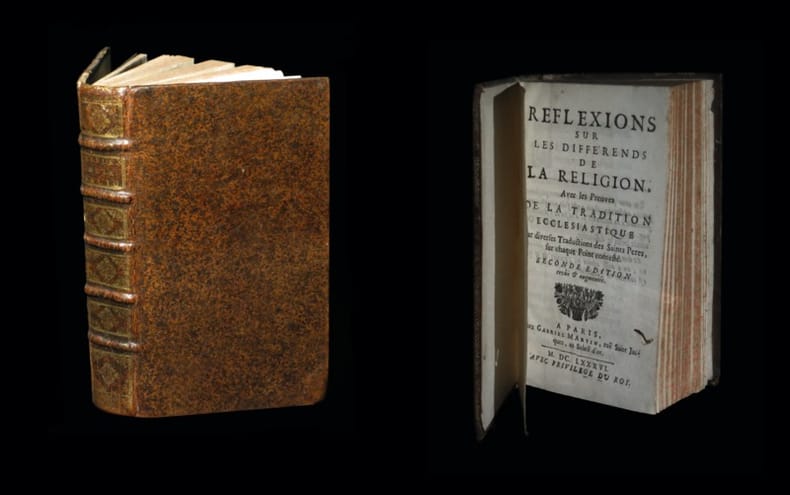
|
|
|
A cura di A. Lamarra e R. Palaia.
Unit? e molteplicit? nel pensiero filosofico e scientifico di Leibniz. Simposio Internazionale (Roma, 3-5 ottobre 1996).
cm. 17 x 24, x-286 pp. Lessico intellettuale europeo Sono raccolti i risultati di tre giornate di studio dedicate a temi assolutamente centrali e caratteristici della speculazione del filosofo tedesco: i concetti di unit? e di molteplicit?, nel loro reciproco richiamarsi, costituiscono due polarit?, due termini antagonisti ma complementari, del pensiero leibniziano e ne caratterizzano in maniera specifica esiti e svolgimenti. A collection of the results of a 3 day symposium dedicated to themes characteristic of the speculation of the German philosopher: the concepts of unity and multiplicity, in their continual attraction, create dual polarity, two antagonistic yet complementary expressions of Leibniz?s thought characterising its development in a specific way. 542 gr. x-286 p.
|
|
|
A cura di A. Lamarra.
Infinito (L') in Leibniz. Problemi e terminologia. Atti del simposio internazionale (Roma, 6-8 novembre 1986).
cm. 17 x 24, x-250 pp. Lessico intellettuale europeo 452 gr. x-250 p.
|
|
|
AA.VV.
LINGUAGGIO, MENTE, CONOSCENZA. INTORNO A LEIBNIZ. A CURA DI STEFANO GENSINI
DISPONIBILITÀ GARANTITA AL 99%; SPEDIZIONE ENTRO 12 ORE DALL'ORDINE. RIMANENZA DI MAGAZZINO PARI AL NUOVO. LIEVISSIMI SEGNI DEL TEMPO. Il ruolo centrale svolto dal filosofo tedesco Gottfried Wilhelm Leibniz (1646-1716) nello sviluppo della riflessione sul linguaggio e la conoscenza in Europa fra Seicento e Settecento è l'oggetto di studio di questo libro. La innovatività del contributo di Leibniz è affidata sia alla sua personalissima elaborazione teorica (con l'idea del funzionamento "cieco o simbolico" del pensiero e la connessa attribuzione al linguaggio di una funzione attiva, non solo strumentale, nella formazione della conoscenza), sia alla rete straordinaria di contatti e stimoli scientifici intessuta coi maggiori dotti del tempo. I grandi nomi della tradizione retorica, filosofi come Cartesio, Hobbes, Spinoza, Locke spiccano fra i moltissimi interlocutori, diretti o indiretti, della ricerca leibniziana, cui si rifaranno, dopo la morte del grande filosofo, pensatori centrali del periodo successivo, da De Brosses a Herder, fino a coinvolgere temi dell'attuale dibattito in filosofia della mente. I contributi raccolti in questo volume, opera di noti studiosi di Leibniz e di storici delle idee linguistiche, illustrano i "casi" più importanti di questo ricchissimo confronto filosofico-linguistico che ha influito in maniera notevole sulla formazione del paradigma "semiotico" della moderna teoria della conoscenza. Indice Premessa, di S. Gensini 1. Tra Valla e Scaligero: Leibniz, la linguistica rinascimentale e il problema del cambiamento semantico, di Francesco Piro 2. Impegno "editoriale" e temi retorici nella prefazione a Nizolio, di Giovanna Varani 3. Leibniz alla caccia di Spinoza, di Enrico Pasini 4. De Brosses e Leibniz: un modello di naturalismo linguistico, di Marina De Palo 5. Eins in Vielem: motivi leibniziani nella filosofia del linguaggio di Herder, di Ilaria Tani 6. Spiral Lines: Aspects of Leibniz' Language Philosophy and Semiotics, by Klaus Dutz 7. Spiegazione e riduzione: Leibniz e i filosofi della mente, di Clotilde Calabi Gli autori Indice dei nomi Descrizione bibliografica Titolo: Linguaggio, mente, conoscenza. Intorno a Leibniz Autore: AA.VV. (Autori Vari) Curatore: Stefano Gensini Editore: Roma: Carocci, febbraio 2005 Lunghezza: 224 pagine; 22 cm ISBN: 8843027816, 9788843027811 Collana: Volume 310 di Biblioteca di testi e studi, Filosofia Soggetti: Filosofia, Università, Gottfried Wilhelm von Leibniz, Saggi, Storia della scienza e della cultura scientifica, Linguaggio universale, Rinascimento, Linguistica, Language and languages, Philosophy, Forschung, Heinekamp, Dascal, Monadi, Metafisica, Conoscenza, Matematica, Filosofi tedeschi del XVIII secolo, Scienza, Logica, Panglossismo, Candide, Voltaire, Characteristica universalis, Calcolo, Ars combinatoria, Simboli, Dalgarno, J. J. Becher, J. Wilkins, Numeri, Arabi, Cina, Sinologia, Segni, Fonemi, Significato, Pasigrafia, Monadologia, Formule, Lettere, Equazioni, Giudizi, Giordano Bruno, Notazione, Proposizioni, Cartesio, Marsenne, Semantica, Liber observationum, Loci rhetorici, Scritti giovanili, Opere, Libri fuori catalogo, Dissertatio de Arte combinatoria, Intelletto umano, Scritti filosofici, University, Essays, History of science and scientific culture, Universal language, Renaissance, Linguistics, Monads, Metaphysics, Knowledge, Mathematics, 18th century German philosophers, Science, Logic, Panglossism, Calculus, Symbols, Dalgarno, Numbers, Arabic, China, Sinology, Signs, Phonemes, Meaning, Pasigraphy, Monadology, Formulas, Letters, Equations, Judgments, Notation, Propositions, Descartes, Semantics, Youth Writings, Works, Books not in the catalog, Combinatorial Art, Human Intellect, Philosophical Writings

|
|
|
Aa.Vv.
Physis Volume XXVIII
Mm 170x240 Rivista internazionale di storia della scienza fascicolo 3. Brossura editoriale di 648-1026 pagine,alcune illustrazioni, piccolo segno d'uso alla testa del dorso. Testo inglese-italiano. Ottimo stato. Spedizione entro 24 ore dalla conferma dell'ordine.
|
|
|
Aceti G.
Indagini sulla concezione leibniziana della felicità. In: Rivista di filosofia neo-scolastica.
Milano, Università Cattolica del Sacro Cuore, 1957, in-8, br. editoriale, pp. (45). Estratto.
|
|
|
ADAMS Robert Merrihew
Leibniz. Determinist, theist, idealist
Oxford, Oxford University Press 1994 xi + 433pp., 24cm., previous owner's name on front endpaper, hardcover (cloth), dustwrapper, VG
Bookseller reference : F66949
|
|
|
ADAMS Robert Merrihew
Leibniz. Determinist, theist, idealist
xi + 433pp., 24cm., previous owner's name on front endpaper, hardcover (cloth), dustwrapper, VG
|
|
|
Adolph Friedrich Heinrich Schaumann Gottfried Wilhelm Freiherr Von Leibniz
Geschichte der Erwerbung der Krone Grossbritanniens von Seiten des Hauses Hannover. Aus Akten und Urkunden des Archivs zu Hannover und den Manual-Akten Leibnitz's. German Edition
British Library Historical Print Editions 2011-03-28. Paperback. Good. British Library, Historical Print Editions paperback
Bookseller reference : SONG1241551502 ISBN : 1241551502 9781241551506

|
|
|
Ahn, Jong-Su
Leibniz' Philosophie und die Chinesische Philosophie. [Konstanzer Dissertationen. 273]. Dissertation, Konstanz.
Konstanz, Hartung-Gorre 1990. 8°. 271 pp. Broschur. Kleines Signaturschild. Stempel verso Titel. Sonst ordentlich.
Bookseller reference : 6045854
|
|
|
Aiton, Eric J
Gottfried Wilhelm Leibniz : eine Biographie. Aus dem Engl. übertr. von Christiana Goldmann und Christa Krüger 1. Aufl.
Frankfurt am Main ; Leipzig : Insel-Verl., 1991. 532 S. Mit Illustr. 8°. Originalleineneinband mit Schutzumschlag.
Bookseller reference : 29076

|
|
|
Aiton, Eric J. und Gottfried Wilhelm Leibniz
Gottfried Wilhelm Leibniz : eine Biographie. Aus dem Engl. übertr. von Christiana Goldmann und Christa Krüger 1. Aufl.
Frankfurt am Main ; Leipzig : Insel-Verl. 1991. 532 S. : Abbildungen., graph. Darst. ; 21 cm, mit Schutzumschlag Gewebe, gebundene Ausgabe, Leinen, Exemplar in gutem Erhaltungszustand
Bookseller reference : 11579

|
|
|